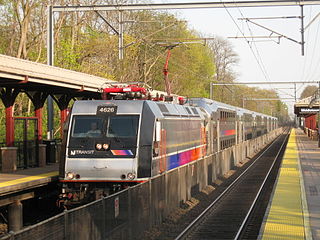
Commuter rail, or suburban rail, is a passenger rail transport service that primarily operates within a metropolitan area, connecting commuters to a central city from adjacent suburbs or commuter towns. Generally commuter rail systems are considered heavy rail, using electrified or diesel trains. Distance charges or zone pricing may be used.
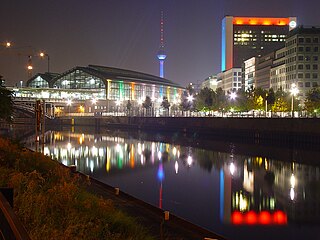
The Berlin S-Bahn is a rapid transit railway system in and around Berlin, the capital city of Germany. It has been in operation under this name since December 1930, having been previously called the special tariff area Berliner Stadt-, Ring- und Vorortbahnen. It complements the Berlin U-Bahn and is the link to many outer-Berlin areas, such as Berlin Brandenburg Airport. As such, the Berlin S-Bahn blends elements of a commuter rail service and a rapid transit system.

The Hamburg S-Bahn is a suburban commuter railway network in the Hamburg Metropolitan Region. Together, the S-Bahn, the Hamburg U-Bahn, the AKN railway and the regional railway form the backbone of railway public transport in the city and the surrounding area. The network has operated since 1907 as a commuter rail system, under the direction of the state railway, and is a member of the Hamburger Verkehrsverbund. There are six lines, serving 68 stations, on 147 kilometres (91 mi) of route. On an average working day the S-Bahn transports about 590,000 passengers; in 2010 about 221 million people used the S-Bahn.

Berlin Hauptbahnhof is the main railway station in Berlin, Germany. It came into full operation two days after a ceremonial opening on 26 May 2006. It is located on the site of the historic Lehrter Bahnhof, and on the Berlin S-Bahn suburban railway. The station is operated by DB Station&Service, a subsidiary of Deutsche Bahn AG, and is classified as a Category 1 station, one of 21 in Germany and four in Berlin, the others being Berlin Gesundbrunnen, Berlin Südkreuz and Berlin Ostbahnhof.

Stadtbahn is a German word referring to various types of rail transport. One type of transport originated in the 19th century, firstly in Berlin and followed by Vienna, where rail routes were created that could be used independently from other traffic.

The Vienna S-Bahn is a suburban commuter rail network in Vienna, Austria. As opposed to the city-run urban metro network, the Vienna U-Bahn, it extends beyond the borders of the city, is operated by the ÖBB, and consists of many branch lines. S-Bahn is short for Schnellbahn, which can be translated as "rapid railway".

Berlin Jannowitzbrücke is a station in the Mitte district of Berlin. It is served by the S-Bahn lines , , , and and the U-Bahn line . It is located next to the Jannowitz Bridge (Jannowitzbrücke) and is a public transport interchange. South of the station is Brückenstraße and north of it are Holzmarkstrasse and Alexanderstraße. The station also serves as a stop for various private excursion and sightseeing boats, among others, those of the Stern und Kreisschiffahrt and Reederei Riedel companies.

The Berlin Stadtbahn is a major railway thoroughfare in the German capital Berlin, which runs through Berlin from east to west. It connects the eastern district of Friedrichshain with Charlottenburg in the west via 11 intermediate stations including Hauptbahnhof. The Berlin Stadtbahn is often also defined as the slightly longer route between Ostkreuz and Westkreuz, although this is not technically correct.

The Ringbahn is a 37.5 km (23.3 mi) long circle route around Berlin's inner city area, on the Berlin S-Bahn network. Its course is made up of the double tracked S-Bahn ring and the parallel freight ring. The S-Bahn lines S 41 (clockwise) and S 42 (counterclockwise) have the rare continual service pattern of a full ring, without a terminus. In addition, the Lines S45, S46 and S47 use a section of the southern and western Ring, while the Lines S8 and S85 use section of the eastern Ring. The combined number of passengers is about 400,000 passengers a day. Due to its distinctive shape, the line is often referred to as the Hundekopf.

Berlin-Spandau station is a Deutsche Bahn station in the Berlin district of Spandau on the south-western edge of the old town of Spandau. The railway junction station is one of the 80 stations classified by Deutsche Bahn as a category 2 station. It has the longest train shed in Germany.

Berlin Tiergarten is a railway station on the Berlin Stadtbahn line in the Tiergarten district of Berlin. It lies between the stations of Zoologischer Garten and Bellevue on the Straße des 17. Juni in the Hansaviertel locality of the Mitte borough. It opened in 1885 and is served by the S-Bahn lines , , and and located very close to the Großer Tiergarten park. The station is part of the Stadtbahn viaduct and has heritage listing.

Berlin Westkreuz is a station in the Charlottenburg district of Berlin. It is served by the S-Bahn lines S3, S41, S42, S46, S5, S7 and S9 and so represents a major interchange point on the Berlin S-Bahn network. It lies at the opposite end of the Stadtbahn to Ostkreuz and is one of the four main stations on the Ringbahn.
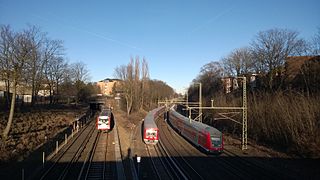
Rapid transit in Germany consists of four U-Bahn systems and fourteen S-Bahn systems. The U-Bahn commonly understood to stand for Untergrundbahn are conventional rapid transit systems that run mostly underground, while the S-Bahn or Stadtschnellbahn are commuter rail services, that may run underground in the city center and have metro-like characteristics in Hamburg and Berlin which they only have to a lesser extent in other cities. There are also over a dozen premetro or Stadtbahn systems that are rapid transit in the city center and light rail outside.
Berlin has developed a highly complex transportation infrastructure providing very diverse modes of urban mobility. 979 bridges cross 197 kilometers of innercity waterways, 5,334 kilometres (3,314 mi) of roads run through Berlin, of which 73 kilometres (45 mi) are motorways. Long-distance rail lines connect Berlin with all of the major cities of Germany and with many cities in neighboring European countries. Regional rail lines provide access to the surrounding regions of Brandenburg and to the Baltic Sea.

Potsdam-Babelsberg station is an S-Bahn station in the Potsdam district of Babelsberg. It is located on the tracks of an extension of the Wannsee Railway between Griebnitzsee station and Potsdam Hauptbahnhof. It is classified by Deutsche Bahn as a category 5 station.
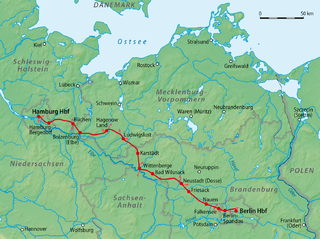
The Berlin–Hamburg Railway is a roughly 286 km (178 mi) long railway line for passenger, long-distance and goods trains. It was the first high-speed line upgraded in Germany to be capable of handling train speeds of over 200 km/h (120 mph).
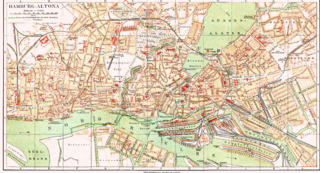
The Hamburg-Altona link line is a railway line in Hamburg, Germany. It now connects the lines from the north and west of Hamburg and Altona station with Hamburg Hauptbahnhof and the lines to the south and east. It was initially designed as a freight line only but is it now one of the busiest lines in Germany. It includes the suburban tracks of the Hamburg Stadtbahn, originally the core of the Hamburg S-Bahn.

S21 is a planned second north-south route for the Berlin S-Bahn, of which the first section is under construction

Siemensstadt-Fürstenbrunn station was a suburban station on the Berlin–Hamburg railway in Westend, a locality of the Charlottenburg-Wilmersdorf borough in Berlin. It was primarily built for workers at its nearby Siemens Works in the neighbouring quarter of Siemensstadt.

The Berlin S-Bahn began on 8 August 1924 with the first section from Stettiner Vorortbahnhof to Bernau using steam locomotives. On 13 August 1961 it was broken up when the Berlin Wall was built, resulting in two sections: the eastern part and the western part. The western part experienced a massive strike which resulted in closure of several stations, after declining use. Attempts were made to reopen at various times but in the end, only three lines were finally opened after the strike. Since 9 November 1989, when the Berlin Wall was opened, the Berlin S-Bahn began to expand rapidly with their budgetary costs.











































